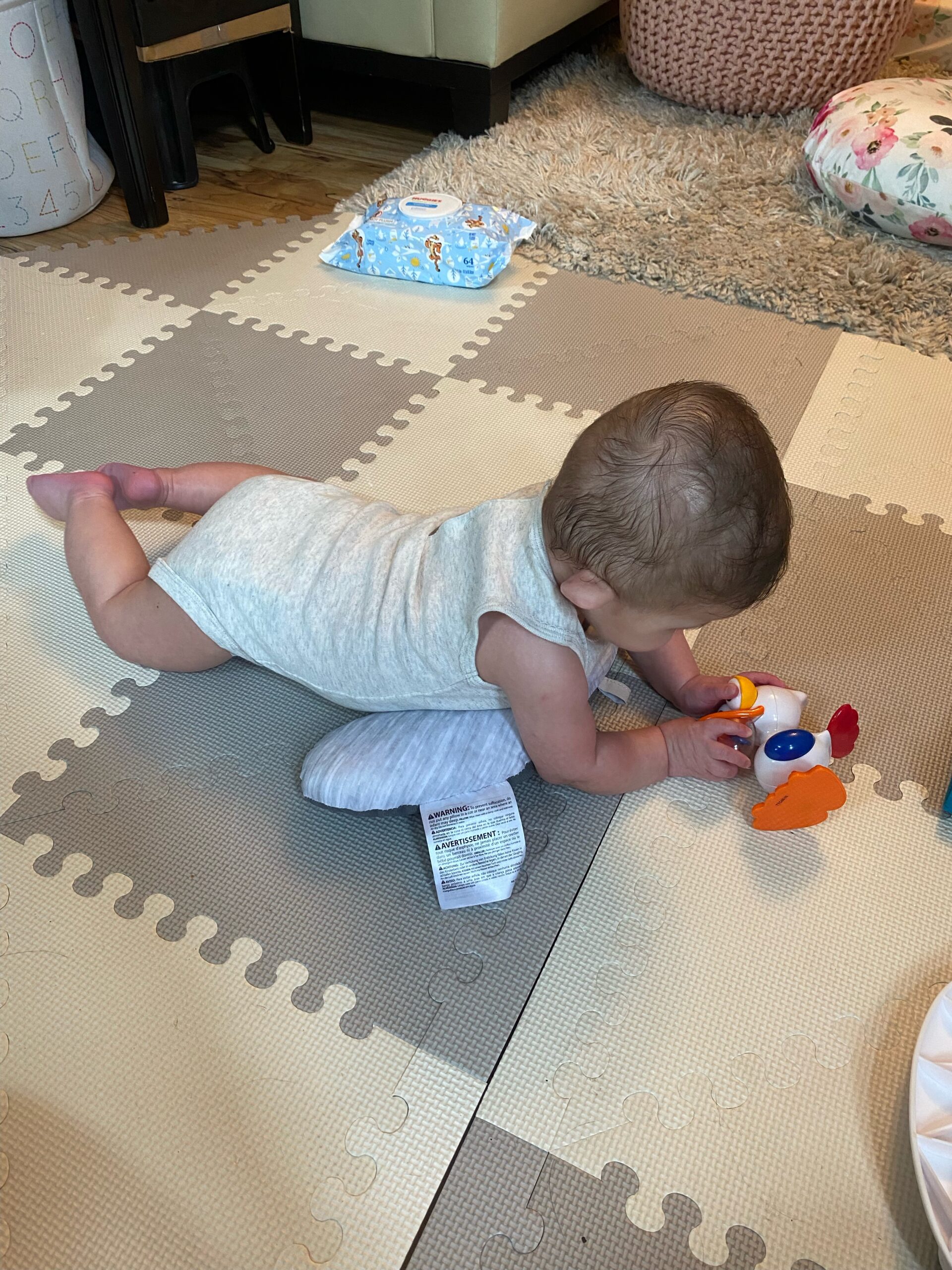In our last blog we talked about all of the different positions babies can play in for the first few months of life. These positions are important to allow our infants to begin stretching and strengthening the muscles in their trunk, hips, and shoulders along with learning how to use their arms and legs with more purpose. These activities are essential to being successful with skills such as rolling and sitting which are some of the next gross motor milestones we want to see our kiddos meeting.
When watching kiddos around 3 or 4 months old, one of the first things we want to see them doing is holding their head in line with their body, not leaning or turning to one side or the other predominantly. We also want them to bring both of their hands together in the middle of their body. Both of these things let me know that infants are gaining body awareness and coordination equally on both sides.
As children are first moving their body, be it their eyes, arms, or legs, the movements are very random and uncoordinated. They struggle to focus on people near them, whether they are moving or still, and only accidentally come in contact with toys dangled from above. With practice, the connections in the brain become stronger and infants are better able to recreate movements and make them more purposeful. They begin to focus on Mom and Dad’s faces and even watch them as them move. When toys are placed in front of them, they are able to reach and grab the toy with both hands, holding it against the center of their chest. All of this practice leads to them eventually being able to hold their own toys (around 4-6 months) and bottle (between 6 and 10 months).
When kiddos are stronger and more coordinated we start thinking about progressing an infant’s positioning from purely on their back, tummy, or side to things such as propping on their forearms, pushing up on their hands, and sitting. In these positions kiddos can begin to interact with their world in more advanced ways. Instead of using only flexor or only extensor muscles, we start moving our body in ways that require us to fluidly move back and forth between both muscle groups and sometimes use them at the same time in order to hold still in certain positions. The reward for all this complex learning is more advanced skills such as rolling.
Most kiddos start rolling from tummy to back and it usually starts accidentally around 4 months old. At birth, the length and weight of a newborn’s head is about 1/4 to 1/3 that of their body. So when kiddos start picking their head up onto tiny arms during tummy time sometimes the weight of their head pulls them to one side and they may roll onto their back without meaning to. Every time this happens they further strengthen their trunk muscles in order to keep it from happening, but they also learn how to make it happen on purpose. One of the things parents can do to help this happen is to make sure that when kiddos are on their tummy they are keeping their hands and arms tucked against their body and under their shoulders.
Around 6 months old they are more coordinated and have spent a few months strengthening their tummy muscles. You may also remember that around this age kiddos often start lifting their legs straight up while lying on their back. This may lead to them accidentally rolling onto their side and once there, they may straighten their legs below them and pick up their head, which completes the roll onto their tummy. Parents can help encourage this by offering a toy out beside them when they are lying on their back. As the child reaches for the toy you can move it more above them in order to encourage them to lift their head and roll over their arm and onto their tummy. When starting this move, you may also need to help hold you kiddo’s bottom down while they try to lift their head since it is so heavy to pick up. While you are helping your kiddo learn to roll, make sure you are practicing going both directions. We want to keep kiddos symmetrical in their strength and abilities as long as possible. Although we do eventually develop a dominant hand and leg, that ideally doesn’t happen for a few years.
If your kiddo is struggling with reaching out for toys, will only roll in one direction, or if you have any other questions about how to support your kiddo’s growth and development reach out for an evaluation. Our therapists at Kid Physical have over 34 combined years experience offering specialized, holistic healthcare for children of all ages. Our top priority is providing support for both caregivers and children so that they can reach their highest potential.

